Data Visualization Report: Evaluating Weather Visualizations in Sydney
VerifiedAdded on 2023/01/18
|7
|1314
|84
Report
AI Summary
This report provides an in-depth analysis of data visualization techniques, focusing on the weather reports of Sydney. The report examines the structure and meaning of the rain radar and text-based visualizations, exploring both their spatial and temporal attributes. It delves into different classes of techniques, including scientific versus information visualization, spatial versus non-spatial visualization, and continuous versus discrete data visualization, and determines whether the data is nominal or ordinal. Furthermore, the report evaluates the strengths and weaknesses of each technique and discusses how context is provided through the use of filters, groups, and sets. The analysis draws on the provided weather report visualizations and aims to assess the student's understanding of visualization designs.
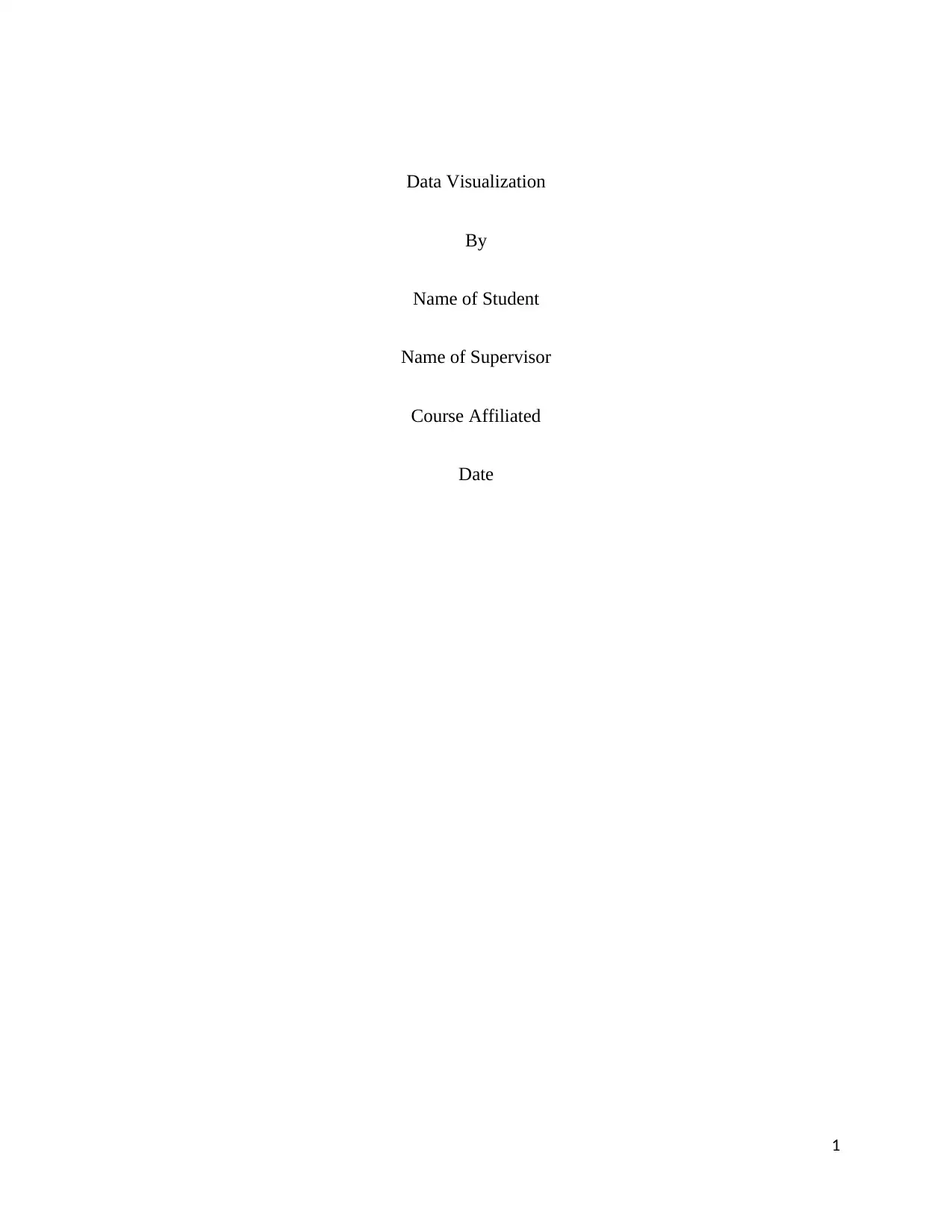
Data Visualization
By
Name of Student
Name of Supervisor
Course Affiliated
Date
1
By
Name of Student
Name of Supervisor
Course Affiliated
Date
1
Paraphrase This Document
Need a fresh take? Get an instant paraphrase of this document with our AI Paraphraser
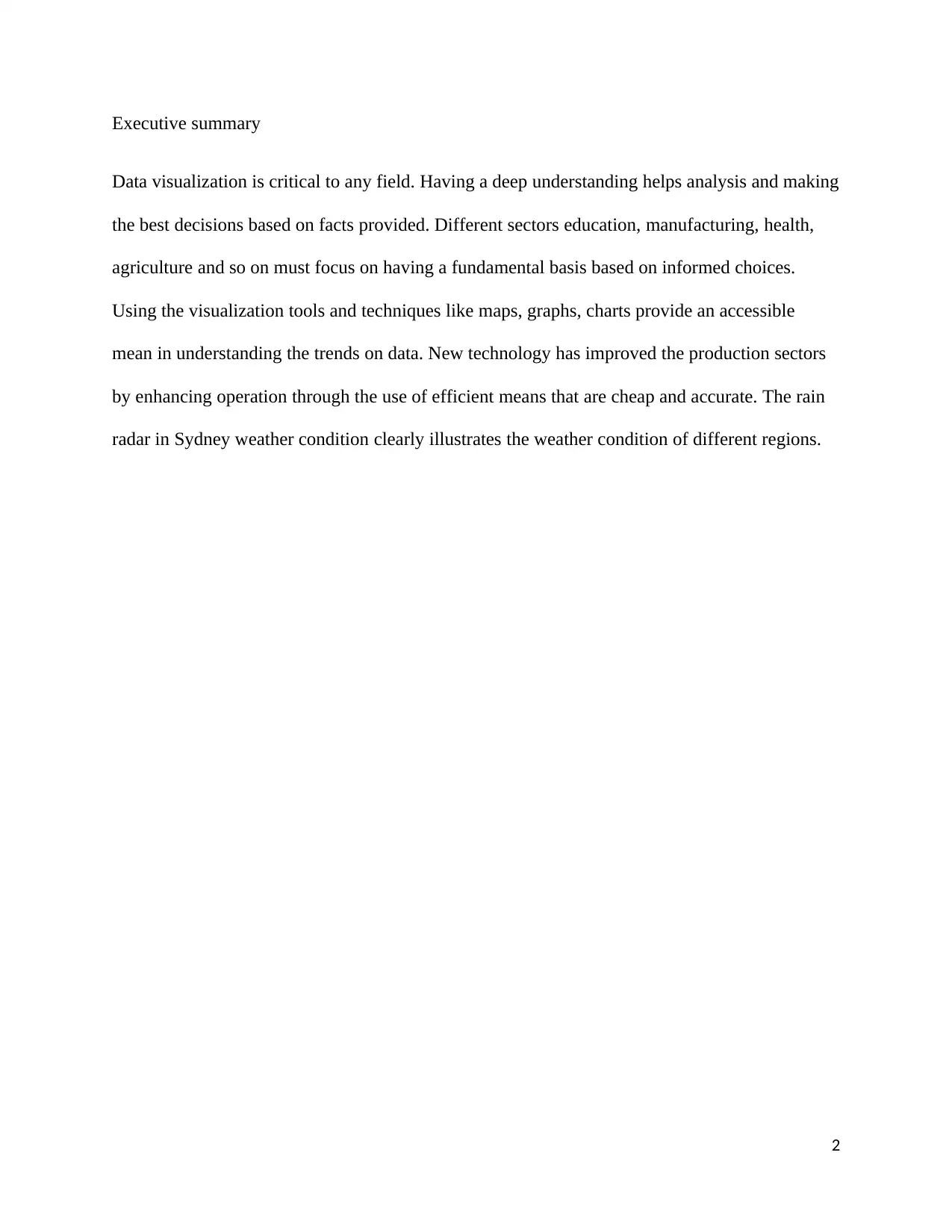
Executive summary
Data visualization is critical to any field. Having a deep understanding helps analysis and making
the best decisions based on facts provided. Different sectors education, manufacturing, health,
agriculture and so on must focus on having a fundamental basis based on informed choices.
Using the visualization tools and techniques like maps, graphs, charts provide an accessible
mean in understanding the trends on data. New technology has improved the production sectors
by enhancing operation through the use of efficient means that are cheap and accurate. The rain
radar in Sydney weather condition clearly illustrates the weather condition of different regions.
2
Data visualization is critical to any field. Having a deep understanding helps analysis and making
the best decisions based on facts provided. Different sectors education, manufacturing, health,
agriculture and so on must focus on having a fundamental basis based on informed choices.
Using the visualization tools and techniques like maps, graphs, charts provide an accessible
mean in understanding the trends on data. New technology has improved the production sectors
by enhancing operation through the use of efficient means that are cheap and accurate. The rain
radar in Sydney weather condition clearly illustrates the weather condition of different regions.
2
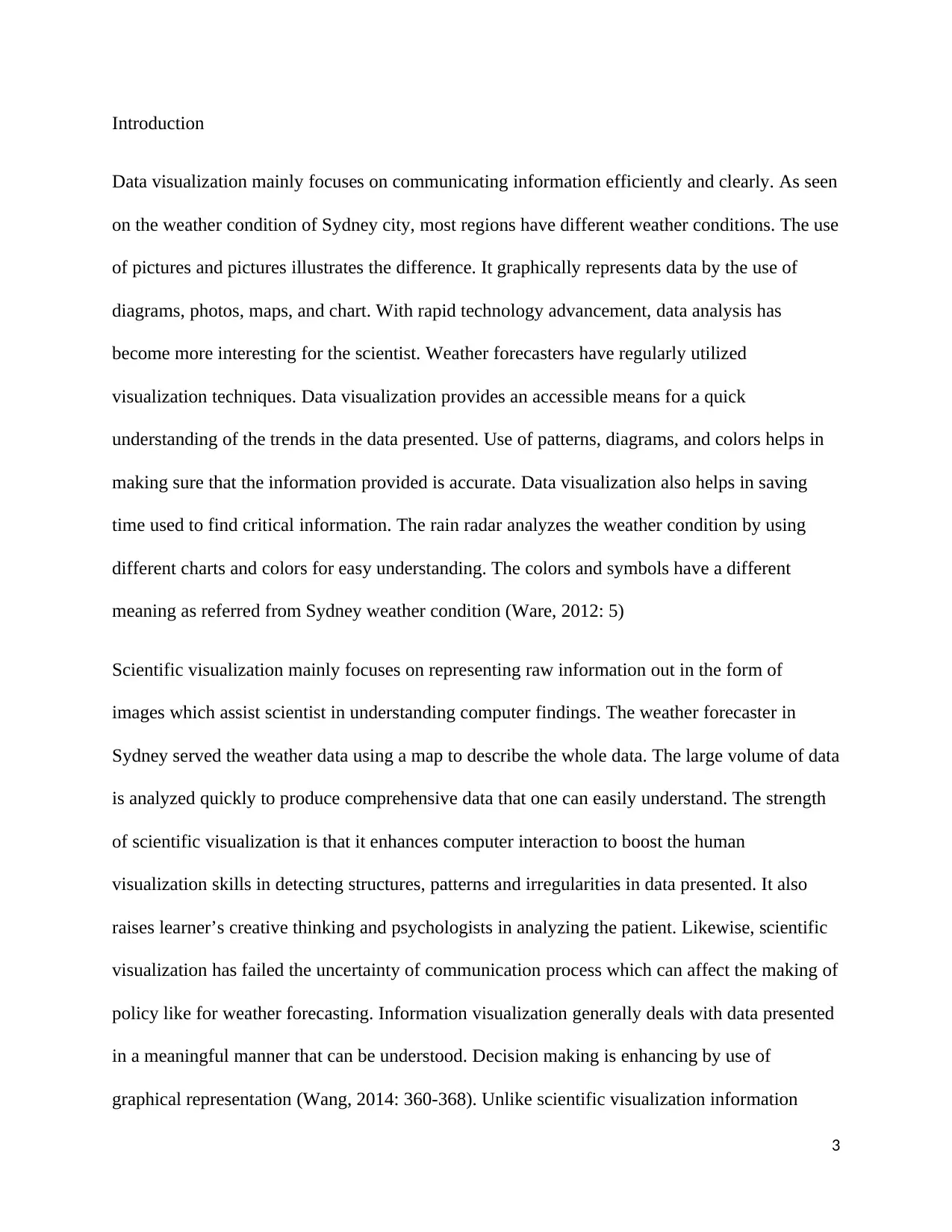
Introduction
Data visualization mainly focuses on communicating information efficiently and clearly. As seen
on the weather condition of Sydney city, most regions have different weather conditions. The use
of pictures and pictures illustrates the difference. It graphically represents data by the use of
diagrams, photos, maps, and chart. With rapid technology advancement, data analysis has
become more interesting for the scientist. Weather forecasters have regularly utilized
visualization techniques. Data visualization provides an accessible means for a quick
understanding of the trends in the data presented. Use of patterns, diagrams, and colors helps in
making sure that the information provided is accurate. Data visualization also helps in saving
time used to find critical information. The rain radar analyzes the weather condition by using
different charts and colors for easy understanding. The colors and symbols have a different
meaning as referred from Sydney weather condition (Ware, 2012: 5)
Scientific visualization mainly focuses on representing raw information out in the form of
images which assist scientist in understanding computer findings. The weather forecaster in
Sydney served the weather data using a map to describe the whole data. The large volume of data
is analyzed quickly to produce comprehensive data that one can easily understand. The strength
of scientific visualization is that it enhances computer interaction to boost the human
visualization skills in detecting structures, patterns and irregularities in data presented. It also
raises learner’s creative thinking and psychologists in analyzing the patient. Likewise, scientific
visualization has failed the uncertainty of communication process which can affect the making of
policy like for weather forecasting. Information visualization generally deals with data presented
in a meaningful manner that can be understood. Decision making is enhancing by use of
graphical representation (Wang, 2014: 360-368). Unlike scientific visualization information
3
Data visualization mainly focuses on communicating information efficiently and clearly. As seen
on the weather condition of Sydney city, most regions have different weather conditions. The use
of pictures and pictures illustrates the difference. It graphically represents data by the use of
diagrams, photos, maps, and chart. With rapid technology advancement, data analysis has
become more interesting for the scientist. Weather forecasters have regularly utilized
visualization techniques. Data visualization provides an accessible means for a quick
understanding of the trends in the data presented. Use of patterns, diagrams, and colors helps in
making sure that the information provided is accurate. Data visualization also helps in saving
time used to find critical information. The rain radar analyzes the weather condition by using
different charts and colors for easy understanding. The colors and symbols have a different
meaning as referred from Sydney weather condition (Ware, 2012: 5)
Scientific visualization mainly focuses on representing raw information out in the form of
images which assist scientist in understanding computer findings. The weather forecaster in
Sydney served the weather data using a map to describe the whole data. The large volume of data
is analyzed quickly to produce comprehensive data that one can easily understand. The strength
of scientific visualization is that it enhances computer interaction to boost the human
visualization skills in detecting structures, patterns and irregularities in data presented. It also
raises learner’s creative thinking and psychologists in analyzing the patient. Likewise, scientific
visualization has failed the uncertainty of communication process which can affect the making of
policy like for weather forecasting. Information visualization generally deals with data presented
in a meaningful manner that can be understood. Decision making is enhancing by use of
graphical representation (Wang, 2014: 360-368). Unlike scientific visualization information
3
⊘ This is a preview!⊘
Do you want full access?
Subscribe today to unlock all pages.

Trusted by 1+ million students worldwide

visualization generally deals with the specific analysis of data that assist experts in making a
critical analysis. The advantage is the ability to display large data in the form of the textual
display; it helps in creating new ideas from raw data. Information visualization has the weakness
of lacking tools to explain the data presented; scientist uses different drawing that brings
confusion due to lack of consistency, there is also no guidance on the use of a pattern that one
can follow and data security is not guaranteed.
Spatial visualization used in to teach IQ training and learning .It is the ability to mentally
analyzed data using two-dimensional and three-dimensional figures. It handles user interfaces to
measure cognitive test and predicting user performance. Spatial reasoning helps to conclude the
objects with a limited source of information Video game implementation apply spatial reasoning.
The coastal region of Sydney experience different weather condition, to illustrate these different
symbols and color is applied which enhance visualization (Cantrell, 2010: 34). Spatial data helps
in describing location address latitude and so on. The weakness of spatial visualization is it is
hard to partition the data into small parts, and it is hard to run query data jointly. Non-spatial
information describes the location attributes. It accurately describes data in a wide perceptive
than spatial visualization. The non-spatial is essential in analyzing critical data and present an
extensive solution. The disadvantage of non-spatial data visualization is that it mainly focused on
exploring a single source of data while ignoring another possibility of weakness in the result
(Sporns, 2013: 162)
Continuous data visualization involves quantitative information which is measurable. The data
has infinite value.
4
critical analysis. The advantage is the ability to display large data in the form of the textual
display; it helps in creating new ideas from raw data. Information visualization has the weakness
of lacking tools to explain the data presented; scientist uses different drawing that brings
confusion due to lack of consistency, there is also no guidance on the use of a pattern that one
can follow and data security is not guaranteed.
Spatial visualization used in to teach IQ training and learning .It is the ability to mentally
analyzed data using two-dimensional and three-dimensional figures. It handles user interfaces to
measure cognitive test and predicting user performance. Spatial reasoning helps to conclude the
objects with a limited source of information Video game implementation apply spatial reasoning.
The coastal region of Sydney experience different weather condition, to illustrate these different
symbols and color is applied which enhance visualization (Cantrell, 2010: 34). Spatial data helps
in describing location address latitude and so on. The weakness of spatial visualization is it is
hard to partition the data into small parts, and it is hard to run query data jointly. Non-spatial
information describes the location attributes. It accurately describes data in a wide perceptive
than spatial visualization. The non-spatial is essential in analyzing critical data and present an
extensive solution. The disadvantage of non-spatial data visualization is that it mainly focused on
exploring a single source of data while ignoring another possibility of weakness in the result
(Sporns, 2013: 162)
Continuous data visualization involves quantitative information which is measurable. The data
has infinite value.
4
Paraphrase This Document
Need a fresh take? Get an instant paraphrase of this document with our AI Paraphraser
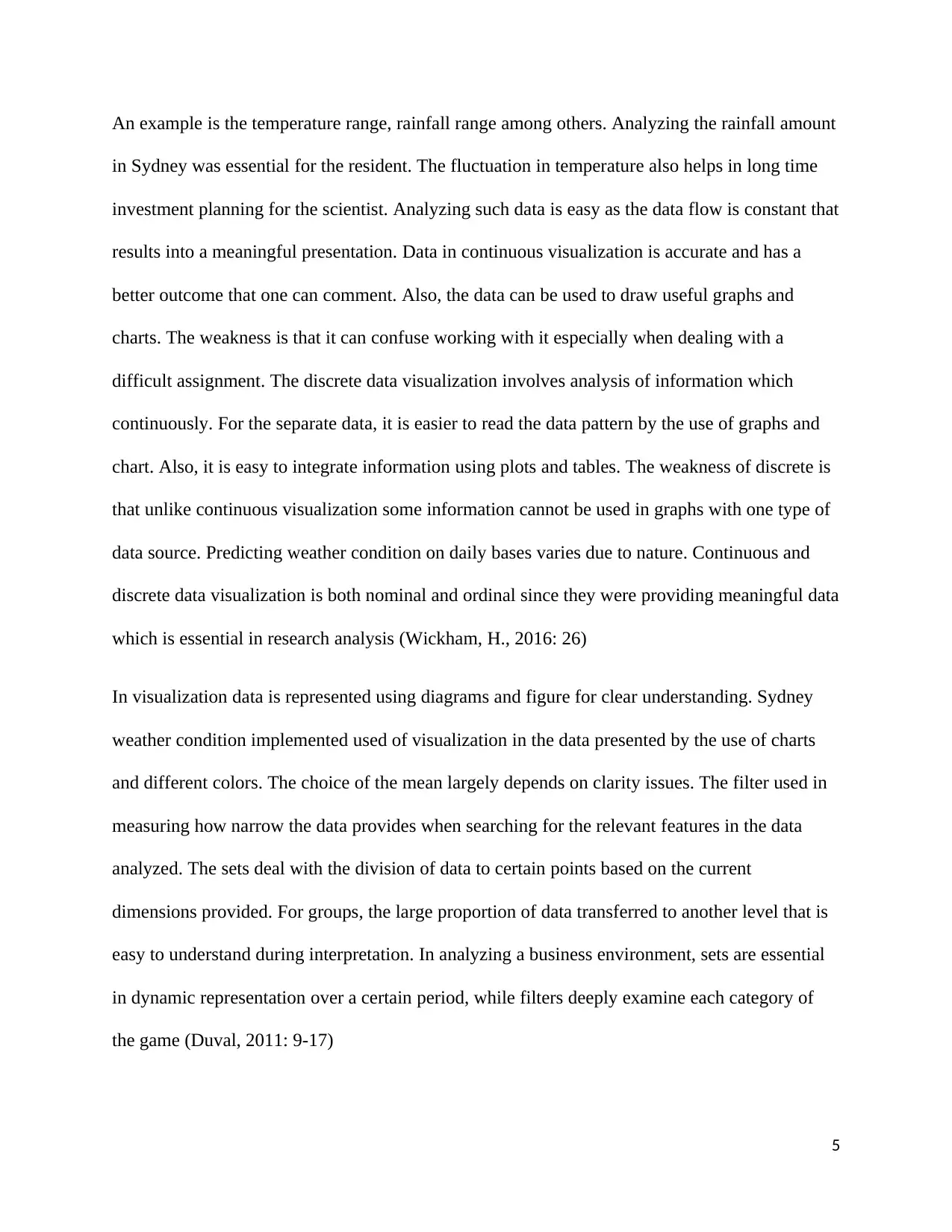
An example is the temperature range, rainfall range among others. Analyzing the rainfall amount
in Sydney was essential for the resident. The fluctuation in temperature also helps in long time
investment planning for the scientist. Analyzing such data is easy as the data flow is constant that
results into a meaningful presentation. Data in continuous visualization is accurate and has a
better outcome that one can comment. Also, the data can be used to draw useful graphs and
charts. The weakness is that it can confuse working with it especially when dealing with a
difficult assignment. The discrete data visualization involves analysis of information which
continuously. For the separate data, it is easier to read the data pattern by the use of graphs and
chart. Also, it is easy to integrate information using plots and tables. The weakness of discrete is
that unlike continuous visualization some information cannot be used in graphs with one type of
data source. Predicting weather condition on daily bases varies due to nature. Continuous and
discrete data visualization is both nominal and ordinal since they were providing meaningful data
which is essential in research analysis (Wickham, H., 2016: 26)
In visualization data is represented using diagrams and figure for clear understanding. Sydney
weather condition implemented used of visualization in the data presented by the use of charts
and different colors. The choice of the mean largely depends on clarity issues. The filter used in
measuring how narrow the data provides when searching for the relevant features in the data
analyzed. The sets deal with the division of data to certain points based on the current
dimensions provided. For groups, the large proportion of data transferred to another level that is
easy to understand during interpretation. In analyzing a business environment, sets are essential
in dynamic representation over a certain period, while filters deeply examine each category of
the game (Duval, 2011: 9-17)
5
in Sydney was essential for the resident. The fluctuation in temperature also helps in long time
investment planning for the scientist. Analyzing such data is easy as the data flow is constant that
results into a meaningful presentation. Data in continuous visualization is accurate and has a
better outcome that one can comment. Also, the data can be used to draw useful graphs and
charts. The weakness is that it can confuse working with it especially when dealing with a
difficult assignment. The discrete data visualization involves analysis of information which
continuously. For the separate data, it is easier to read the data pattern by the use of graphs and
chart. Also, it is easy to integrate information using plots and tables. The weakness of discrete is
that unlike continuous visualization some information cannot be used in graphs with one type of
data source. Predicting weather condition on daily bases varies due to nature. Continuous and
discrete data visualization is both nominal and ordinal since they were providing meaningful data
which is essential in research analysis (Wickham, H., 2016: 26)
In visualization data is represented using diagrams and figure for clear understanding. Sydney
weather condition implemented used of visualization in the data presented by the use of charts
and different colors. The choice of the mean largely depends on clarity issues. The filter used in
measuring how narrow the data provides when searching for the relevant features in the data
analyzed. The sets deal with the division of data to certain points based on the current
dimensions provided. For groups, the large proportion of data transferred to another level that is
easy to understand during interpretation. In analyzing a business environment, sets are essential
in dynamic representation over a certain period, while filters deeply examine each category of
the game (Duval, 2011: 9-17)
5
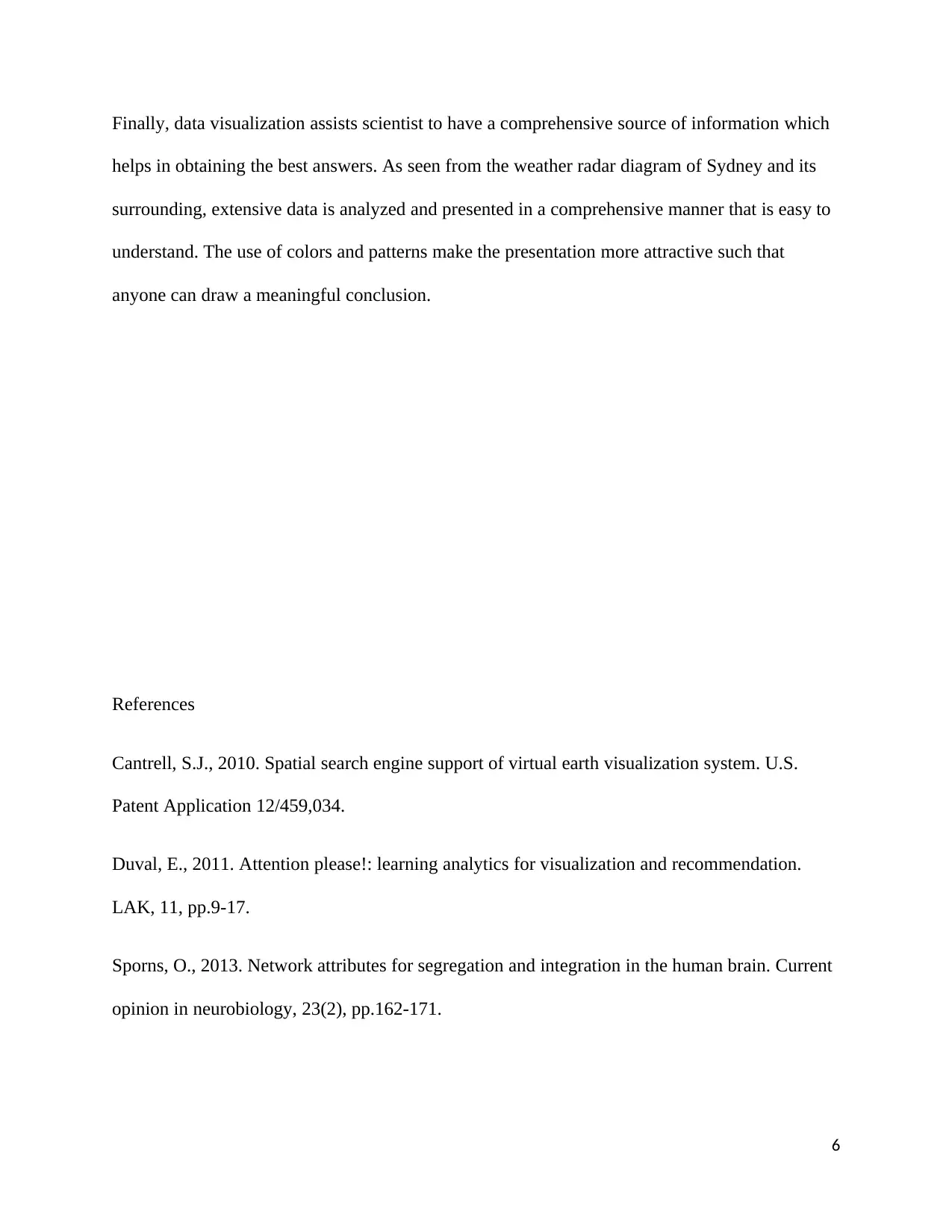
Finally, data visualization assists scientist to have a comprehensive source of information which
helps in obtaining the best answers. As seen from the weather radar diagram of Sydney and its
surrounding, extensive data is analyzed and presented in a comprehensive manner that is easy to
understand. The use of colors and patterns make the presentation more attractive such that
anyone can draw a meaningful conclusion.
References
Cantrell, S.J., 2010. Spatial search engine support of virtual earth visualization system. U.S.
Patent Application 12/459,034.
Duval, E., 2011. Attention please!: learning analytics for visualization and recommendation.
LAK, 11, pp.9-17.
Sporns, O., 2013. Network attributes for segregation and integration in the human brain. Current
opinion in neurobiology, 23(2), pp.162-171.
6
helps in obtaining the best answers. As seen from the weather radar diagram of Sydney and its
surrounding, extensive data is analyzed and presented in a comprehensive manner that is easy to
understand. The use of colors and patterns make the presentation more attractive such that
anyone can draw a meaningful conclusion.
References
Cantrell, S.J., 2010. Spatial search engine support of virtual earth visualization system. U.S.
Patent Application 12/459,034.
Duval, E., 2011. Attention please!: learning analytics for visualization and recommendation.
LAK, 11, pp.9-17.
Sporns, O., 2013. Network attributes for segregation and integration in the human brain. Current
opinion in neurobiology, 23(2), pp.162-171.
6
⊘ This is a preview!⊘
Do you want full access?
Subscribe today to unlock all pages.

Trusted by 1+ million students worldwide
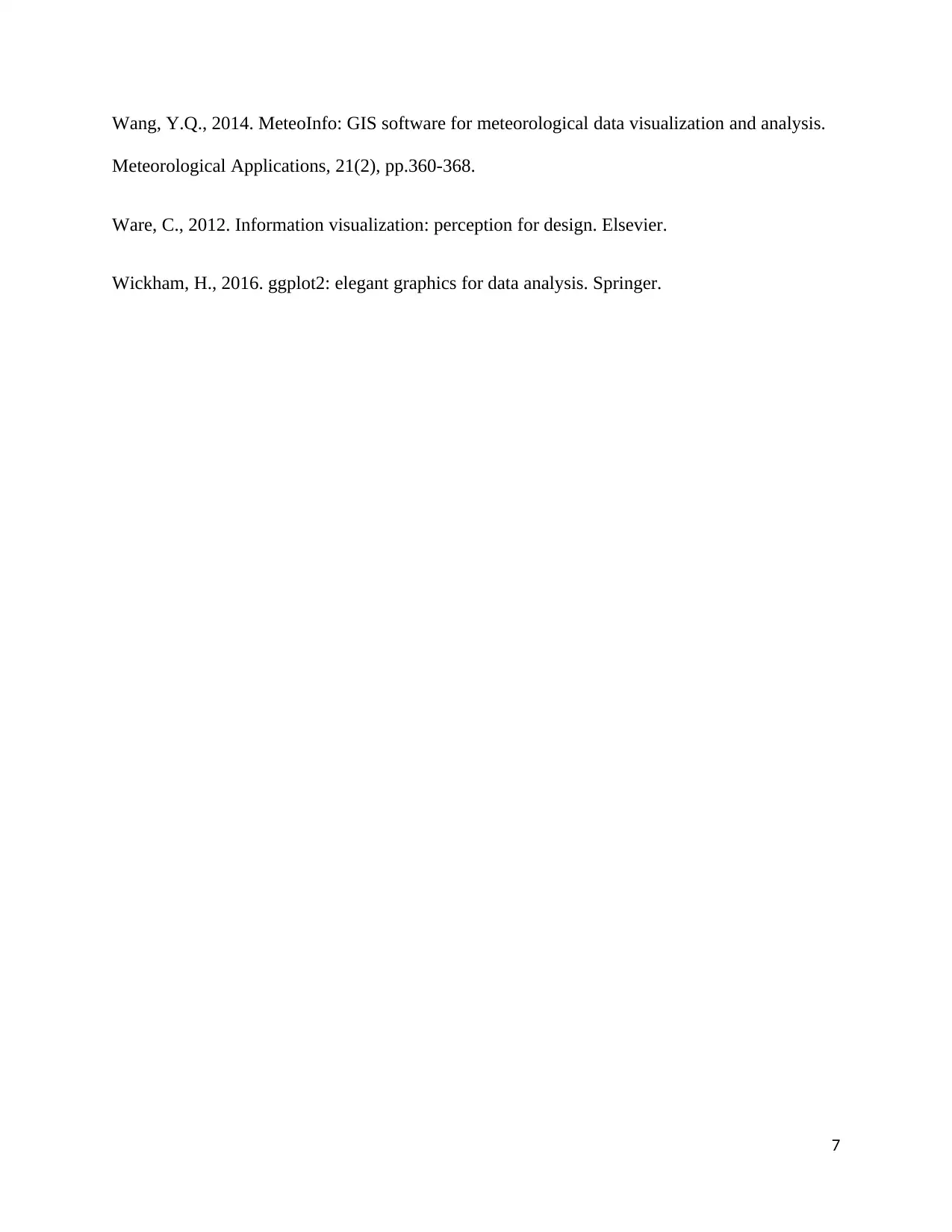
Wang, Y.Q., 2014. MeteoInfo: GIS software for meteorological data visualization and analysis.
Meteorological Applications, 21(2), pp.360-368.
Ware, C., 2012. Information visualization: perception for design. Elsevier.
Wickham, H., 2016. ggplot2: elegant graphics for data analysis. Springer.
7
Meteorological Applications, 21(2), pp.360-368.
Ware, C., 2012. Information visualization: perception for design. Elsevier.
Wickham, H., 2016. ggplot2: elegant graphics for data analysis. Springer.
7
1 out of 7
Related Documents
Your All-in-One AI-Powered Toolkit for Academic Success.
+13062052269
info@desklib.com
Available 24*7 on WhatsApp / Email
![[object Object]](/_next/static/media/star-bottom.7253800d.svg)
Unlock your academic potential
Copyright © 2020–2025 A2Z Services. All Rights Reserved. Developed and managed by ZUCOL.



